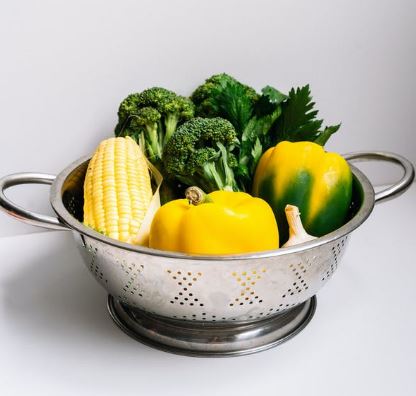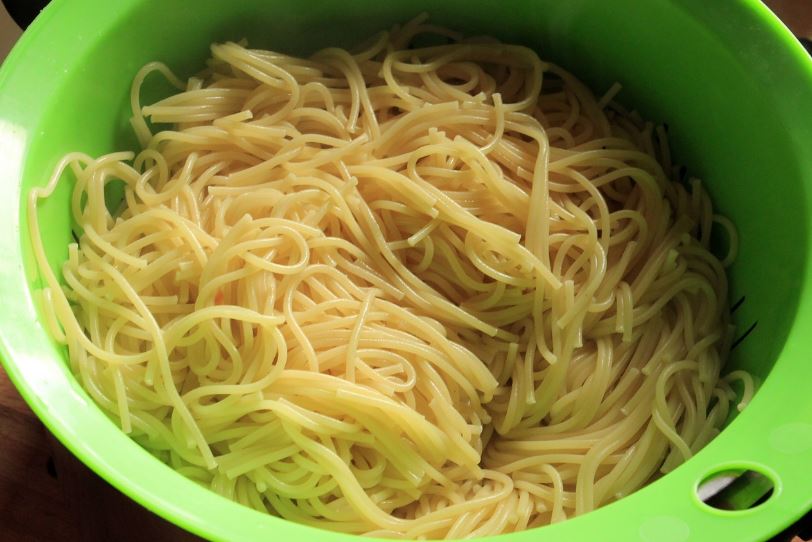A colander is a kitchen tool typically used for rinsing vegetables and straining dishes like pasta. The bottom of the container is punctured, allowing liquids to drain while particles remain contained.
Although they are often crafted from lightweight metals like aluminum or thin stainless steel, colanders may also be manufactured from other materials including plastic, silicone, ceramic, or enamelware. Colanders are used to strain food before serving. In most cases, they take the form of bowls; you may have come across an item that is referred to as a “mated colander pot.”
Ways You Can Use a Colander
Although a colander is essential for tasks like draining pasta and rice and washing fruit, there are various more ways in which this simple piece of cookware may be put to even greater use.
- Use to serve fries. If you want to make oven fries or French fries at home, a metal colander will allow you to eat them while they are still boiling hot and crisp. After allowing the fries to drain in the colander, transfer them to the big bowl made of stainless steel. The dish that is enclosing the colander helps to keep the fries heated while also preventing them from becoming soggy.
- Fruit storage containers. It’s possible for the bottoms of containers containing fragile fruits like blueberries and raspberries to get moldy and mushy. The best method to store them in the refrigerator is in a colander since this keeps them from being crushed and enables air to flow underneath them. The same tip is effective for preventing bruising in grapes, peaches, pears, strawberries, and other types of fruit that are kept on a level surface during storage.
- Prevent Splatters of Grease. While frying an egg or a burger, you may prevent most of the fat spray from escaping the pan by inverting a colander over the top of the pan. This also enables water vapor and heat to leave the pan more easily. This method is effective because the molecules of fat are considerably larger than the molecules of water, and as a result, they are unable to escape through the gaps.
- Use in Steaming Vegetables. It is not a problem at all if you do not have a steam basket with you right now. A colander is the tool that will save the day. They are able to steam vegetables just as well as conventional vegetable steamers by placing the colander that is stuffed with veggies inside of a bigger pan that is filled with water.
- Draining Food from Cans. If you want to keep the liquids when you strain canned juice, a colander will be a very helpful tool. Just put the colander on top of a larger bowl, pour the fruit into the colander, and let the juice drain into the larger bowl. It’s that easy.
Types of Colanders
View this post on Instagram
- Metal: The top of the bowl of a metal colander will typically have a rim around it. When you’re using the colander, the base of the colander should typically be stable enough to prevent the colander from toppling over. Additionally, the base raises the colander a few inches, preventing food from coming into contact with the base of the sink.
- Plastic: Colanders made of plastic often feature a clip on one side that allows them to be attached to the edge of the sink for convenient draining. There are some plastic colanders that have a base like metal colanders, but there are also ones that do not. The handles on the majority of plastic colanders are on both sides, while others feature a single long handle instead. Plastic colanders have a possibility of being stained over time.
- Silicon: Colanders made of silicone are often foldable for simple storage. Unlike metal colanders, most silicone colanders lack a base. When working with liquid, the silicone substance is often non-slip to prevent movement in the sink.
- Ceramic: Most colanders made of ceramic only have holes in the bottom.
What Is a Trap Door Colander?
The innovative new Trap Door Colander eliminates the risk of spills and messes that are associated with conventional colanders by including a practical trap door bottom that allows for effortless dispensing into a bowl or serving dish. After you have strained the pasta, just pull on the levers that are positioned neatly below the handles to open either one of the trap doors or both of them, depending on the quantity of pasta that you would want to serve.
The patented design of the Trap Door Colander is made so that food can drop right into a bowl or plate by pulling the levers under the handles. This makes the two trap doors on the bottom open and safely transfer the food. When you use this colander, you won’t have to pour from the top, so it will fill up and not spill. Foods like pasta, vegetables, berries, and more are easy to strain, drain, and serve with this.
All-plastic construction with dimensions of 5.12 x 11.54 x 13.58 inches. The whole unit has a maximum capacity of 5 quarts, which should be plenty for making meals for a modest household.
The Farberware strainer appears like any other, but it has a unique feature: two trap doors at the bottom. The food is dispensed into a bowl or onto a plate by opening the two trap doors on each side of the colander once it has been filled and strained.
No more pouring means no more spills, steam burns, and it works well for folks who have arthritis and can’t flip a colander over anymore.
The food bottom adds stability by elevating the colander and your food above the sink floor.
BPA-free and dishwasher safe.
To Sum Up:
Kitchen tools are a big help when it comes to keeping the kitchen clean and in order, and you need to find the right tools for your kitchen needs. A Trap Door Colander is a must have, after all, you don’t want to witness any spills, do you?



